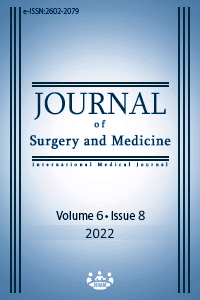Does uterus volume affect the total laparoscopic hysterectomy outcomes?
Results of total laparoscopic hysterectomy
Keywords:
Laparoscopic hysterectomy, Uterine volume, Surgery outcomeAbstract
Background/Aim: Increased uterus weight, high body mass index (BMI), and history of abdominal surgeries increase the risk of complications in total laparoscopic hysterectomy (TLH), similar to other types of surgery. However, there are conflicting reports about improving technology. This study aimed to retrospectively investigate the clinical features and postoperative results of TLH cases regarding uterine volume performed for benign reasons in our clinic.
Methods: In this retrospective cohort study, 252 patients were included. The demographic data of all patients, including BMI, pre-operative uterine volumes, operation times, number of cesarean sections, history of lower abdominal operation, indications, pre-operative and postoperative hemoglobin differences, complications, length of hospital stay, and final pathologies were reviewed. The uterine volume was measured using the prolate ellipsoid formula before surgery, using the maximum length and anteroposterior and transverse diameters of the uterine corpus. The normal uterine volume with these measurements (8 cm long, 4 cm high, and 5 cm wide) was estimated as 83.2 cm3. The patients were classified into two groups according to uterine volume (normal volume ≤ 83.2 or above). Surgical outcomes of patients were compared between groups.
Results: Two-hundred-fifty-two women were included in the study. The mean uterine volumes of groups 1 and 2 were 53.66 cm3 (2.25) and 296.33 cm3 (6.25), respectively. In group 1, the mean operation time was 111.14 (6) min, compared to 118.2 (3.06) min in group 2; there was no significant difference (P = 0.164). The mean postoperative hospital stays of groups 1 and 2 were 3.21 (0.15) and 3.34 (0.09) days, respectively, and there was no significant difference (P = 0.706). The mean blood loss values of groups 1 and 2 were 1.34 g/dl (0.19) and 1.16 g/dl 0.06), respectively.
Conclusion: According to our results, TLH is a safe method even in patients with a larger uterus; operating time, blood loss, and postoperative hospital stays did not differ according to uterine volume.
Downloads
References
Cheung VYT, Rosenthal DM, Morton M, Kadanka H. Total laparoscopic hysterectomy: a five-year experience. J Obstet Gynaecol Can. 2007;29(4):337-43. doi: 10.1016/S1701-2163(16)32429-X. PubMed PMID: 17475127. DOI: https://doi.org/10.1016/S1701-2163(16)32429-X
ACOG Committee Opinion No. 444: choosing the route of hysterectomy for benign disease. Obstet Gynecol. 2009;114(5):1156-8. doi: 10.1097/AOG.0b013e3181c33c72. PubMed PMID: 20168127. DOI: https://doi.org/10.1097/AOG.0b013e3181c33c72
Cohen SL, Vitonis AF, Einarsson JI. Updated hysterectomy surveillance and factors associated with minimally invasive hysterectomy. JSLS. 2014;18(3). doi: 10.4293/JSLS.2014.00096. PubMed PMID: 25392662; PubMed Central PMCID: PMC4208898. DOI: https://doi.org/10.4293/JSLS.2014.00096
O’Hanlan KA, McCutcheon SP, McCutcheon JG. Laparoscopic hysterectomy: impact of uterine size. J Minim Invasive Gynecol. 2011;18(1):85-91. doi: 10.1016/j.jmig.2010.09.016. PubMed PMID: 21195958. DOI: https://doi.org/10.1016/j.jmig.2010.09.016
Goldstein SR, Horii SC, Snyder JR, Raghavendra BN, Subramanyam B. Estimation of nongravid uterine volume based on a nomogram of gravid uterine volume: its value in gynecologic uterine abnormalities. Obstet Gynecol. 1988;72(1):86-90. PubMed PMID: 3288932.
Langer JE, Oliver ER, Lev-Toaff AS, Coleman BG. Imaging of the female pelvis through the life cycle. Radiographics. 2012;32(6):1575-97. doi: 10.1148/rg.326125513. PubMed PMID: 23065159. DOI: https://doi.org/10.1148/rg.326125513
Brummer TH, Jalkanen J, Fraser J, Heikkinen AM, Kauko M, Makinen J, et al. FINHYST, a prospective study of 5279 hysterectomies: complications and their risk factors. Hum Reprod. 2011;26(7):1741-51. Epub 20110503. doi: 10.1093/humrep/der116. PubMed PMID: 21540244. DOI: https://doi.org/10.1093/humrep/der116
Twijnstra AR, Blikkendaal MD, van Zwet EW, van Kesteren PJ, de Kroon CD, Jansen FW. Predictors of successful surgical outcome in laparoscopic hysterectomy. Obstet Gynecol. 2012;119(4):700-8. doi: 10.1097/AOG.0b013e31824b1966. PubMed PMID: 22395145. DOI: https://doi.org/10.1097/AOG.0b013e31824b1966
Koroglu N, Cetin BA, Turan G, Yildirim GY, Akca A, Gedikbasi A. Characteristics of total laparoscopic hysterectomy among women with or without previous cesarean section: retrospective analysis. Sao Paulo Med J. 2018;136(5):385-9. doi: 10.1590/1516-3180.2018.0197030718. PubMed PMID: 30570089. DOI: https://doi.org/10.1590/1516-3180.2018.0197030718
Seo ES, Lee SH, Chon SJ, Jung SY, Cho YJ, Lim S. Influence of previous abdominal surgery on clinical outcomes of patients undergoing total laparoscopic hysterectomy. Obstet Gynecol Sci. 2018;61(3):379-85. Epub 20180508. doi: 10.5468/ogs.2018.61.3.379. PubMed PMID: 29780781; PubMed Central PMCID: PMC5956122. DOI: https://doi.org/10.5468/ogs.2018.61.3.379
Otake A, Horai M, Tanaka E, Toda A, Miyoshi Y, Funada R, et al. Influences of Total Laparoscopic Hysterectomy According to Body Mass Index (Underweight, Normal Weight, Overweight, or Obese). Gynecol Minim Invasive Ther. 2019;8(1):19-24. Epub 20190123. doi: 10.4103/GMIT.GMIT_53_18. PubMed PMID: 30783584; PubMed Central PMCID: PMC6367909. DOI: https://doi.org/10.4103/GMIT.GMIT_53_18
Cianci S, Gueli Alletti S, Rumolo V, Rosati A, Rossitto C, Cosentino F, et al. Total laparoscopic hysterectomy for enlarged uteri: factors associated with the rate of conversion to open surgery. J Obstet Gynaecol. 2019;39(6):805-10. Epub 20190419. doi: 10.1080/01443615.2019.1575342. PubMed PMID: 31001998. DOI: https://doi.org/10.1080/01443615.2019.1575342
Terzi H, Hasdemir PS, Biler A, Kale A, Sendag F. Evaluation of the surgical outcome and complications of total laparoscopic hysterectomy in patients with enlarged uteruses. Int J Surg. 2016;36(Pt A):90-5. Epub 20161019. doi: 10.1016/j.ijsu.2016.10.024. PubMed PMID: 27770638. DOI: https://doi.org/10.1016/j.ijsu.2016.10.024
Kung FT, Chang SY. The relationship between ultrasonic volume and actual weight of pathologic uterus. Gynecol Obstet Invest. 1996;42(1):35-8. doi: 10.1159/000291886. PubMed PMID: 8840176. DOI: https://doi.org/10.1159/000291886
Gerges B, Mongelli M, Casikar I, Bignardi T, Condous G. Three-dimensional transvaginal sonographic assessment of uterine volume as a pre-operative predictor of need to morcellate in women undergoing laparoscopic hysterectomy. Ultrasound Obstet Gynecol. 2017;50(2):255-60. Epub 20170606. doi: 10.1002/uog.15991. PubMed PMID: 27281513. DOI: https://doi.org/10.1002/uog.15991
Downloads
- 680 2000
Published
Issue
Section
How to Cite
License
Copyright (c) 2022 Cevdet Adiguzel, Emre Destegül, Hicran Acar Şirinoğlu, Gülsüm Uysal
This work is licensed under a Creative Commons Attribution-NonCommercial-NoDerivatives 4.0 International License.
















